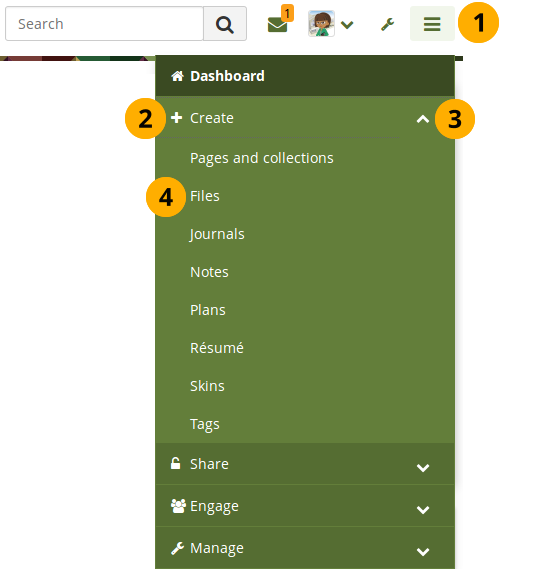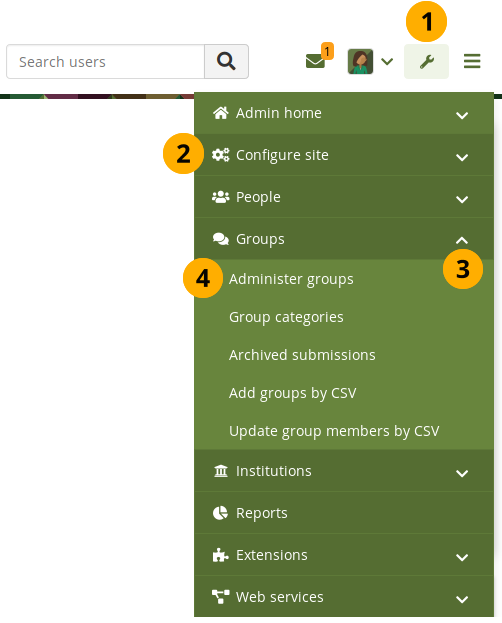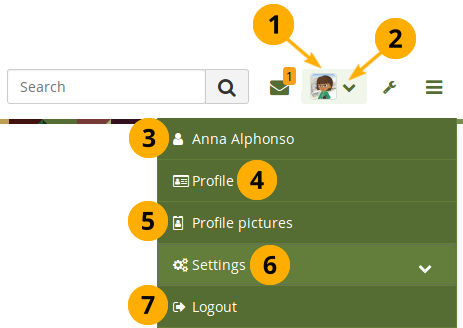3. Dashboard¶
3.1. Einloggen¶
3.1.1. Regular login form¶
Sie müssen sich immer zunächst einloggen, um Zugang zu Ihren persönlichen Informationen, Portfolio-Ansichten und -Gruppen zu erhalten, deren Mitglied Sie sind. Das Login kann direkt auf der Mahara-Homepage erfolgen.
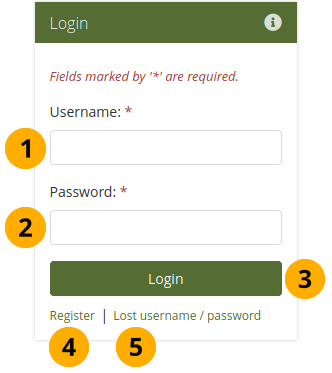
Regular login form¶
Username: Type your username in this field (not for SSO or Moodle accounts).
Kennwort: Tragen Sie Ihr persönliches Zugangskennwort ein. Wenn Sie es fünfmal nacheinander falsch eingegeben haben, wird Ihr Zugriff für fünf Minuten gesperrt.
Klicken Sie auf den Login-Button, um einzutreten.
Registrieren: Wenn Sie noch keinen Account besitzen und die Selbstregistrierung erlaubt ist, kommen Sie hier zu einer Folgeseiten mit den erforderlichen Informationen.
Nutzername/Kennwort vergessen: Wenn Sie sich an Ihren Nutzernamen oder Ihr Zugangskennwort nicht mehr erinnern, klicken Sie auf den Link. Auf der nächsten Seite können Sie eine E-Mail mit einem Link zur Änderung Ihre Zugangsdaten anfordern. Die E-Mail enthält Ihren Nutzernamen und den Zugang zu einer Seite auf der Sie Ihr Zugangskennwort ändern können.
Bemerkung
Das reguläre Loginformular wird nur für interne und LDAP-Acccount verwandt. Interne Accounts wurden direkt in Mahara von Ihnen selbst erstellt oder von Administratoren manuell oder durch CSV-Dateiupload erstellt.
The ‚Lost username / password‘ link only works for internal accounts where you use the regular login form.
If you log in via SSO or Moodle for example, you must retrieve your password directly from these services. If you do not know how to do that, please ask your administrator.
You can hide the login form entirely from the homepage if your Mahara instance generally only connects to an external authentication method such as MNet or CAS. In these cases, people will need to log in via a different site and seeing the login form on the homepage may only be confusing.
Once you have hidden the login form, only a link to it is displayed on the homepage for an administrator to log into the site.

Link zum Anmeldeformular¶
3.1.2. SSO login¶
When you log in via single sign-on, you do not use the regular login form, but you need to log in via the IdP. Therefore, a special SSO button is needed. The SSO button is displayed more prominently to make it easier for people to choose the correct authentication method.
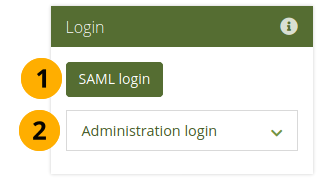
Login form for SSO¶
SAML login: If you log in via your institution’s SSO (single sign-on) account, please use this button to be taken to the SSO login.
Administration login: When you click this panel, you can see the regular login form to get into Mahara without an SSO account.
The SSO button is labelled with the display name of the institution. If that is too long or you want to display something else on the button for another reason, you can create a /htdocs/local/lang/en.utf8/auth.saml.php file and add it there. The button needs to have the key ‚login‘ + shortname of the institution, e.g. for ‚testinstitution‘ it would be: $string['logintestinstitution'] = 'Special label';
Siehe auch
Find out more about making language adjustments in Mahara.
3.2. Login with strict privacy¶
When the site administrator turned on strict privacy, you need to consent to the terms and conditions and the privacy statement of the site and maybe even an institution if you are a member of an institution before you can enter your account. If you don’t, you have the opportunity to discuss your issues with them with an administrator.
Bemerkung
When any of the statements changed, you will be presented with them again and need to make a decision about consenting or not.
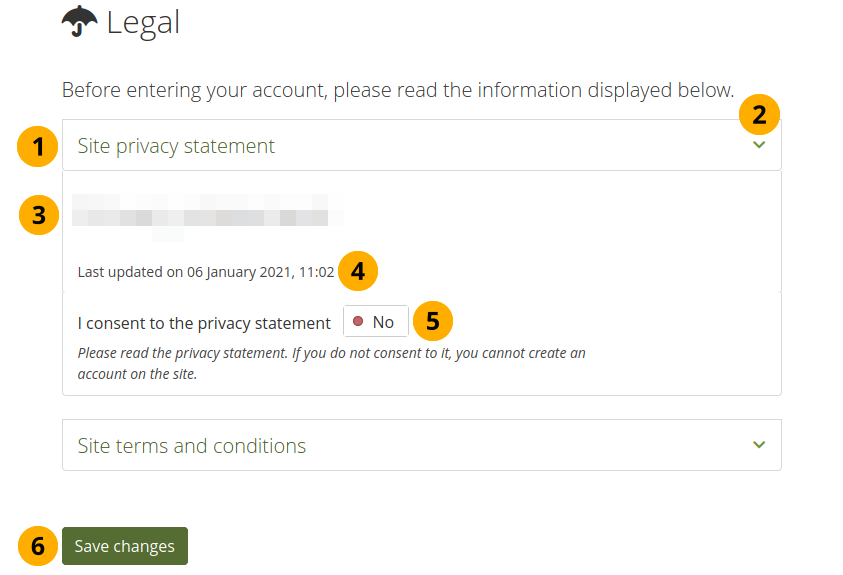
Accept legal statements upon first login¶
Title of the legal statement.
Bemerkung
There can be up to 4 statements that you may need to consent to. This depends on the setup of the site that you use.
Click the Retractable icon to close this section. This is helpful if the texts are very long.
The text of the statement.
The date the statement was last updated is displayed.
If you consent to the statement, flip the switch to ‚Yes‘.
Bemerkung
Before you consent to a statement, please read it carefully. If you do not understand a section or have questions, do not consent to it but leave it set to ‚No‘. When you save your changes, you will have the opportunity to detail why you do not consent and get in touch with the administrator to discuss your concern.
Click the Save changes button to accept your decisions.
3.3. Übersicht¶
You can change certain aspects of your dashboard, namely the personal information, but a lot of what you see is static to allow you to quickly access other parts of Mahara.
Nur Sie selber haben Zugriff auf Ihr persönliches Dashboard. Niemand anders kann es sehen.
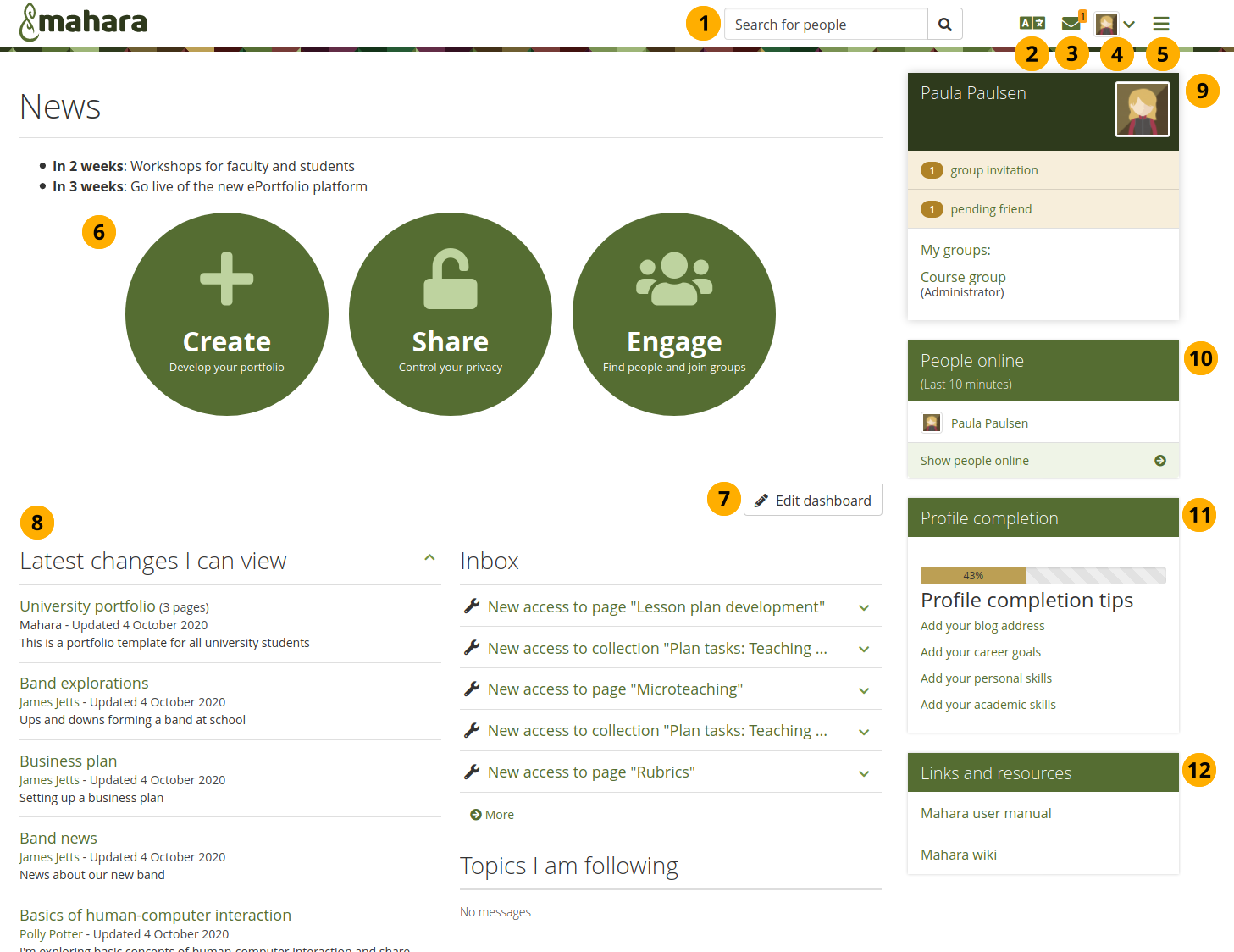
Ihre Homepage ist gleichzeitig Ihr Dashboard, von dem Sie bequemen Zugang zu den unterschiedlichen Bereichen von Mahara haben.¶
Search for people: Search for people who have an account to view their profile page and check which portfolios they have made accessible to you. If your site has fulltext search available, you can search for anything on the site using this search box.
Bemerkung
In the People search box you can most often search for a person’s display name. Depending on the settings that the site administrator made, you may also be able to search for their real name and username. If the site administrator allowed account holders to hide their real name, you can do so in your general account options.
To provide you with the most relevant search results, you automatically search only for people within your own institution, but can choose to search for everyone on your Mahara installation on the ‚People‘ page you are taken to.
If the site administrator turned on exact people search, you need to provide the correct display name or real name in order to find another person.
Click the Language chooser icon to switch to another language that is installed on the site.
Bemerkung
The icon is only visible when there is more than one language available on the site.
When the icon is clicked, the page is reloaded. Thus, if you wrote some text, you’ll be asked if you want to leave the page or not to prevent that your text will be lost.
Inbox: Click the Inbox icon to view all your notifications and send messages.
Account menu: Click the Account menu navigation icon to reach your account settings, profile, profile pictures, legal statements, connected apps, notification settings, and the logout link, or click your profile picture to be taken to your profile page.
Main menu: Use the Main menu navigation icon to navigate to other areas of your portfolio.
Bemerkung
Administrators and staff who have access to the administration area, see the Administration menu navigation icon in addition to the main menu navigation so they can navigate within the administration area.
Schnelle Verlinkungen: Diese schnellen Verlinkungen bringen Sie direkt zu bestimmten Bereichen von Mahara.
Bemerkung
You can remove these quick links (or similar elements if the instance of Mahara you are using has some other content in there) in your general account options, option ‚Dashboard information‘.
Edit dashboard: The Edit dashboard button allows you to jump directly into the edit screen for your dashboard without having to go to Main menu → Create → Pages and Collections first.
Bemerkung
Sie können kein Skin zu Ihrer Dashboardseite hinzufügen.
You can customise this area on your dashboard to put blocks there that you want to see every time you log in.
This sidebar block contains static and dynamic information:
Ihr Name ist mit Ihrer Profilseite verlinkt.
Your profile picture is linked to your profile pictures page where you manage your profile pictures.
If you are a member of any groups, they are displayed here. You can shorten the list by only displaying labelled groups.
Nicht bearbeitete Kontaktanfragen und Gruppeneinladungen werden hier angezeigt.
If you tagged artefacts or pages with the tag ‚profile‘, a link to them is placed here.
Show who is online: If this sidebar block is enabled, you see people who have been logged in during the last 10 minutes. Depending on the settings for your institution that the administrator chose, you may see everyone, only people from your institution(s), or nobody at all.
Profil-Vervollständigung: Sie können den Block in der Seitenleiste sehen, wenn Ihr Site- oder Institutionsadministrator die Profil-Vervollständigungsfunktion eingeschaltet hat.
Links and resources: List of links to websites or documents that are visible to all logged-in people or the public.
3.5. Schnelle Links¶
Wenn Sie sich in Mahara einloggen, sehen Sie drei neue Felder mit schnellen Verlinkungen:
Create: Create your electronic portfolio in a flexible personal learning environment. This takes you to Main menu → Create → Pages and collections.
Share: Share your achievements and development in a space you control. Clicking on this box takes you to Main menu → Share → Shared by me.
Engage: Engage with other people in discussion forums and collaborate in groups. This takes you to Main menu → Engage → Groups.

Mahara Anwendungsinformationen und Informationen, wenn Sie mit Ihrem Cursor über ein Feld fahren.¶
Mit diesen ‚schnellen Links‘ erreichen Sie spezielle Bereiche Ihres Portfolios direkt von Ihrem Dashboard.
Bemerkung
If you removed these boxes from your dashboard but want to get them back at a later point, you can re-active them under Account menu → Settings → Preferences → Dashboard information.
Wenn Sie die Dashboardfelder nicht sehen können und auch keine Möglichkeit haben diese Einstellung zu ändern, hat ihr Site Administrator diese Funktion in der Site Konfiguration ausgeschaltet.
3.6. Personal information¶
Das bereits vorbereitete Dashboard enthält folgende Blöcke:
Latest changes I can view
My portfolios
Eingangsbox
Themen, die ich verfolge
These blocks are filled with content once you start using Mahara and create pages, receive messages from others, have access to others‘ portfolio pages and use the forums for discussions. You can customize these blocks to your liking by editing your dashboard. Click the Edit dashboard button directly on your dashboard or go to Portfolio in the navigation menu, click the Edit button next to the dashboard page and change the blocks like you would change them on any page in Mahara.
Siehe auch
Refer to the section ‚Add content to a page‘ for more information on adding and removing blocks from a page.
The site administrator can change the default blocks on the dashboard page for new account holders in Administration → Configure site → Pages.
